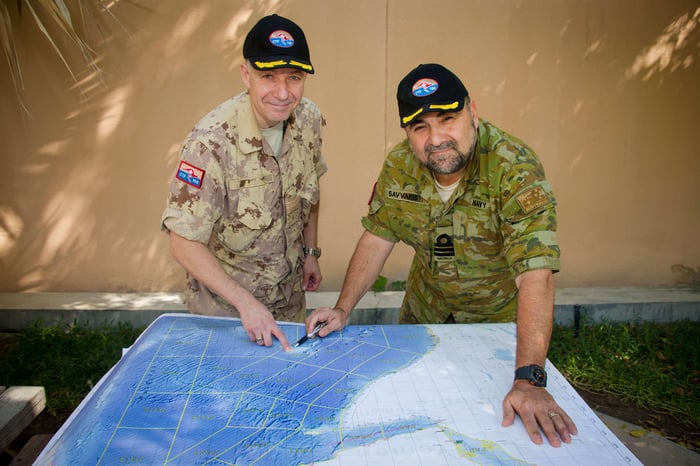
The German Naval Threat in the Indo-Pacific 1914-15
One of the most ill-considered myths surrounding Australia’s Great War involvement suggests that it was a war of choice. Yet, no matter how distant from European affairs we may have seemed, Britain’s enemies had no inclination to view the self-governing dominions as anything but legitimate targets; if not critical in their own right, then useful for applying pressure on the motherland. Like Britain, Australia’s economy remained entirely dependent upon the free movement of its overseas trade. Rendered secure from direct assault by our geographic isolation, only at sea did we face a credible threat.
Few Australians today are aware that Germany once maintained a potent cruiser squadron permanently in East Asian waters. Commanded by Vice Admiral Maximilian von Spee, the squadron had its primary base at Tsingtao within China’s German concession, but roamed widely. Indeed, its units coaled routinely at Rabaul, the capital of German New Guinea and just 1,000 miles from Australia’s coast. In wartime, von Spee could also call on a number of smaller gunboats and several converted merchant ships.
Theoretically, a successful war against trade could cripple the British Empire more quickly than operations on land, and since at least 1900 the Germans had been envisioning a campaign of what they termed ‘Cruiser Warfare’ on the Empire’s periphery. By March 1914 the orders issued to von Spee were clear:
The main objective of all operations is to inflict damage on English trade. Besides the respective strengths and locations of the two armed forces, the initiation and implementation of operations depend predominantly on securing adequate coal supplies. This must therefore be a decisive factor in the choice of a suitable operation area. The ability to depart quickly will force the enemy to search and thus lead to fragmentation of his forces. This will create opportunities to score tactical successes against enemy elements.
By August, the German squadron’s designated priorities were to attack shipping focal areas in the Arabian Sea and off Australia. Had von Spee maintained his freedom of movement, the results could have been disastrous; potentially strangling Allied sea communications and rendering the combined resources of Australia, New Zealand, India and the smaller British colonies strategically irrelevant.
Instead, the German commander faced a situation where superior Allied naval forces prevented him from remaining in the northern Pacific, moving west into the Indian Ocean or south into the Tasman Sea. Only by proceeding east across the Pacific did he hold some chance of obtaining logistic support from neutral territories. It meant the temporary abandonment of cruiser warfare by his main force, but von Spee detached one light cruiser, Emden, to join with Konigsberg, which was already operating off East Africa.
The Germany Admiralty’s preoccupation with European waters played a large part in restricting von Spee’s resources and hence his options, but so too did Australia’s 1909 decision to acquire an effective ocean-going fleet. Even alone, the flagship, HMAS Australia, was powerful enough to defeat the German squadron, but acting together the fleet provided both effective deterrence and a flexible means of maritime power projection. Within days of the war’s outbreak, Australia’s navy had embarked on a succession of wide-ranging and interlocking operations designed to deny von Spee potential bases, disrupt his coal supplies and destroy his wireless communications.
Australian defence planning had never envisaged the complexities of multi-national command, operational sequencing and long-range sustainment that such a maritime campaign entailed. But that it could be completed successfully, owed much to the high level of professionalism inherent to naval training and the fortunate emergence of a remarkably modern conception of naval warfare; one of independent, self-contained and adaptable task-force operations.
By December 1914, the Allies had seen all German possessions in the South Pacific occupied, most enemy auxiliary vessels interned or scuttled, Emden destroyed by HMAS Sydney and von Spee’s elimination almost inevitable. Six separate Allied naval formations were either converging on his position or sealing off his escape into another theatre. Of these, the two most important were a combined Anglo-Japanese force centred on Australia, sailing south along the west coast of South America, and a British squadron mirroring this movement off Argentina. On 10 December, it fell to the latter force to defeat von Spee off the Falkland Islands.
With the German threat essentially removed from the Pacific, the path was clear to redistribute Allied naval forces to areas of greater need. Australia’s major units thereafter proceeded to the West Indies and North Sea, but the small cruiser HMAS Pioneer deployed to East Africa. Here Konigsberg had just been found hiding in the shallow delta of the Rufiji River.
Although her raiding career had been disappointing in comparison with Emden’s, as a force-in-being Konigsberg’s achievements could hardly have been bettered. For almost a year she soaked up the attentions of up to 25 Allied warships and dashed British hopes for the early conquest of German East Africa. Konigsberg’s demise eventually required the use of specialised vessels, with Pioneer providing suppressive fire against enemy positions ashore.
That Australia was spared direct attacks in 1914–15 came down to a combination of German strategic ineptitude and timely recognition by our politicians of where the nation’s strategic vulnerabilities lay. Emden’s successes against merchant traffic, demonstrated what might have been achieved and as one British admiral soon admitted, ‘…we should from the first have controlled the waters of the Pacific and Indian Oceans …It is the existence of the Australian Squadron that has saved the situation.’
A century later Australia remains a maritime nation and just as dependent upon the sea for our economic wellbeing and physical security. Yet, the potential challenges to our oceanic wealth and connections have become far more varied and complex than in 1914. How best we should manage these threats is a question that receives far too little attention in our strategic discourse.
Author - David Stevens is an adjunct associate professor at UNSW at Canberra and a senior visiting fellow at the University of Wollongong. His latest book, In All Respects Ready: Australia’s Navy in World War One, is published by Oxford University Press. Image courtesy of Australian War Memorial
 This article was originally published on The Strategist and is republished here with kind permission.
This article was originally published on The Strategist and is republished here with kind permission.











